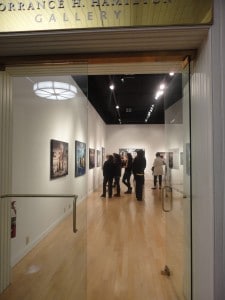By Lauren Kane –
Dystopia (noun): an imagined place or state in which everything is unpleasant or bad, typically a totalitarian or environmentally degraded one. Such a place is depicted in artist Lori Nix’s collection entitled The City, now showing in Antone Center’s Dorrance Hamilton Gallery. The exhibition is simple, pictures hung on the wall, none smaller than 4×2. However, what is happening in within the frame is anything but simple. Nix’s photographs are all of diorama scenes she constructed with the help of her partner, Kathleen, and friends. The opening reception was on Thursday, March 29, from 5-8 p.m. in the Antone Center. Lori Nix was present at this opening, talking with the viewers present. She gave a lecture on the inspiration for her work, how it has changed since 1998, and an example of the process she goes through to create one of these entrancing works.
Nix drew her inspiration for the post-apocalyptic creations of The City from the dystopian films of the 1970’s such as Planet of the Apes and The Towering Inferno. The way she spoke of the photographs was not that they were meant to carry a scary or foreboding feeling with them, but rather one of fascination. Nix wants viewers of The City to be able to imagine themselves wandering in these surreal places where the familiarity of human development meets nature.
Turn out for this reception was busy, with approximately 40 students, professors and members of the community present. The response was very positive.
“I really like it,” said Chiva Kunz, who came after receiving the invitation sent to those on the mailing list. “It’s a huge endeavor. There’s so much going on, and it’s also a sort-of social commentary.”
“I think it’s amazing. It’s crazy that she built all of it,” said Megan Padden, a senior Photography major.
Dan Kaceroski, a student attending the opening, commented on his favorite pieces, one depicting a laundromat during the day and the other at night. These two are of the first scene that Nix shot in both contrasted lighting.
“I like the difference between night and day here,” commented Kaceroski.
Nix has always worked with the idea of disasters. Born and raised in rural Norton Kansas, Nix grew up with a close relationship with natural disasters. She left Kansas for art school, where she studied ceramics and photography.
“I think I’m good at making my camera lie,” said Nix.
Nix has no experience or training in Photoshop, and likes to keep it that way. Every piece of Nix’s scenes are made from something organic, and oftentimes commonplace, such as powdered sugar snow or dental floss power lines. Finding ways to construct a believable scene, such as lightning striking, a flock of birds and many other hard to create things is all a part of the art.
“These are the kind of problems I like to set up for myself,” said Nix.
To create such scenes from scratch takes months, creating three a year, working on two at once on average. The sets range in size from about a half foot tall to about three to four feet tall. Using painting, carving foam, and handmade props, Nix is able to create a beautiful moment to capture on film.
“The hardest thing about working with mini-scenes is creating atmospheres,” said Nix, though the atmosphere of her photographs is never lacking. Nix never works to recreate a specific picture, when drawing inspiration from a place such as a museum or aquarium, but works from her feeling of the experience of being there. Nix also explained that she rarely moves her camera when shooting; she knows exactly what angle she wants to create the feeling of her shot.
The lecture audience drew their breaths, in unison, when Nix was asked what she did with the dioramas and sets once she was done. Simply, she throws them away, recycling materials that can be reused for future projects.
“I want to be known as a painter, not a sculptor,” said Nix, “I’ve been looking at the same scene for the past however many months. I’m done with it.”
The amount of detail, precision and thought that goes into each project requires a patience that Nix finds easy to come by.
“I feel like I have all the time in the world, I never feel rushed. I always have stuff to work on. It does take patience,” said Nix, “The beauty of working in my apartment is that while I’m waiting for glue to dry, or film exposure, I can send e-mails or make myself a snack.”
The worst part of working out of her own house?
“The hardest part of shooting in my apartment is my cats,” joked Nix of her curious and often interfering pets.
Lori Nix’s work has been featured in the Smithsonian and the Museum of Fine Arts in Houston, among many other galleries and collections. For those interested in this intriguing and poignant display, the hours of the Dorrance Hamilton Gallery are on the Salve Regina website, and the exhibition ends on April 18. Lori Nix’s work can be found online at http://www.lorinix.net/















